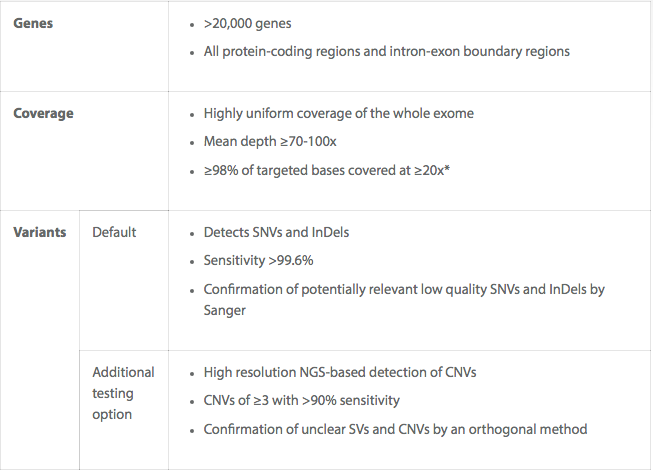CentoXome®
Whole Exome Sequencing
For certain patients the combination of symptoms does not allow the clinician to pinpoint a potential diagnosis. In such challenging cases, often a stepwise diagnostic strategy is chosen, which makes the testing complex, time consuming, costly and often not even conclusive. Furthermore, a delayed diagnosis may have a significant impact on the patient’s treatment and quality of life.
For these cases, the use of broad, whole exome sequencing (WES) has advantages over initially more targeted genetic testing. Whereas such targeted genetic testing focuses on a single gene or on a limited set of predetermined genes, WES testing examines all the protein coding regions in the genome (exons) simultaneously. It is estimated that most of the disease-causing mutations (about 85%) are located within the exons. This lack of bias allows to also identify disease causing mutations in unexpected genes that would be missed by targeted approaches.
CentoXome®, CENTOGENE’s whole exome sequencing service, offers an accurate and cost-effective one-step solution, with high diagnostic yield.

CentoXome® – Key Features

When is Whole Exome Sequencing Required?
For many patients the combination of symptoms does not allow suspecting specific genetic causes with a sufficiently high certainty. It is unclear which genes to look at.
Therefore, WES may be an affordable first test when the clinical spectrum is diverse and diagnostic answers are likely to be obtained only through sequencing the complete coding region, i.e. the whole exome. WES is also a good follow-on approach after more targeted approaches have been tried already and no causative variant was identified.
We particularly recommend WES for patients:
- With clinical or genetic heterogeneity
Examples: Epilepsy, epileptic encephalopathies, muscular dystrophies/muscular disorders, ataxia, neuropathies, cardiomyopathies, skeletal dysplasias, immunodeficiency, deafness, blindness.
- With atypical clinical presentations or phenotypes
Example: A patient presenting with intracranial aneurysm (due to PKD1 gene – polycystic kidney disease)
- With “blended” clinical presentations and clinical suspicion of dual diagnosis
Examples: Intellectual disability and severe immunodeficiency
- With clearly genetic disease, but previous genetic testing having been negative.
Example: A patient with autosomal dominant spastic paraplegia and with a negative result for the gene panel
- Who need a cost-conscious alternative to whole genome sequencing
Clinical Anamnesis and Reporting
Conclusive clinical reports
High-quality reporting is an essential element for building a partnership of trust. Our philosophy is more than just producing technical data. The extensive interpretation of clinical and testing data delivered with our comprehensive medical reports includes differential diagnostic approaches as well as a detailed interpretation of key findings.
CENTOGENE’s large mutation database of rare genetic diseases, CentoMD®, that includes the systematic documentation of curated genetic variants, with detailed clinical information, frequency and geographic origin, coming from a worldwide cohort of patients, strongly strengthens the clinical interpretation of our CentoXome® results and warrants best diagnostic yields. It significantly improves the quality and consistency of the diagnosis, ultimately affecting your patients’ treatment path.
- Detailed evaluation of patient’s clinical information and family history
- Clear results of identified variants that can explain the phenotype
- Variant classification following international best-practice guidelines (ACMG)
- Comprehensive medical interpretation
- Recommendations for differential diagnoses or follow-up analyses for specific diseases
- References to publications supporting the medical and scientific results.
- Detailed description of the genetic testing method, and coverage report of genes
- Report of research variants or incidental findings based on ACMG guidelines (optional) and additional information on pathogenic and likely pathogenic variants listed in CentoMD®, which are known to be related to severe and early-onset diseases (for more information, see details and the list of genes covered).
Clinical anamnesis
One consequence of WES is the increased amount, complexity, and variety of results that need to be interpreted. Therefore, it is of utmost importance to obtain specific and detailed clinical information from the index patient and the parents when performing exome sequencing.
Withholding any clinical information, including your patient’s family history, may affect test results and their interpretation. Missing clinical information could lead to exclusion of genetic variants that might be relevant for the patient. For example, the CentoXome® diagnostic yield improved from about 26% when using few clinical information to about 40% as compared when we received detailed clinical information.

